| |
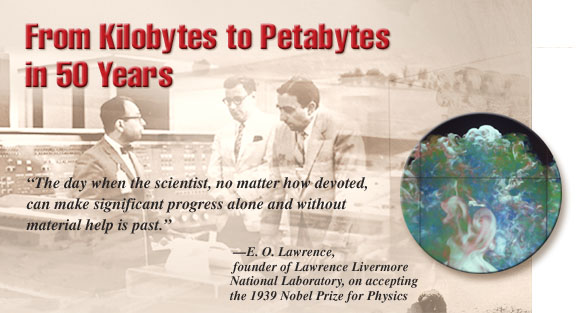
THE
history of Lawrence Livermore National Laboratory is inexorably
tied to the evolution of supercomputers—the largest, fastest,
most powerful computers in the world. Even before the Laboratory’s
gates opened for the first time in September 1952, founders E. O.
Lawrence and Edward Teller recognized that computers were needed
to better calculate the thermonuclear explosions for the nuclear
weapons the “Rad Lab” in Livermore was destined to design.
 Designing nuclear weapons
and predicting their behavior has always been a difficult technical
and scientific challenge. In a thermonuclear explosion, matter is
accelerated to millions of kilometers per hour while experiencing
densities and temperatures found only in stars. In addition, weapon
designers needed to identify and understand the important physical
properties of matter under these exotic conditions. With little
experimental data available, Livermore’s designers turned to
computers to simulate and visualize the processes and the physics
of nuclear weapons. Designing nuclear weapons
and predicting their behavior has always been a difficult technical
and scientific challenge. In a thermonuclear explosion, matter is
accelerated to millions of kilometers per hour while experiencing
densities and temperatures found only in stars. In addition, weapon
designers needed to identify and understand the important physical
properties of matter under these exotic conditions. With little
experimental data available, Livermore’s designers turned to
computers to simulate and visualize the processes and the physics
of nuclear weapons.
 To fulfill its critical national
defense mission, the Laboratory constantly sought out the most advanced
computers with the most capability. In the 1990s, with the cessation
of underground nuclear testing, advanced supercomputers figured
prominently in plans for stockpile stewardship, helping scientists
predict the behavior of the aging nuclear stockpile to better assess
its safety, reliability, and security. To fulfill its critical national
defense mission, the Laboratory constantly sought out the most advanced
computers with the most capability. In the 1990s, with the cessation
of underground nuclear testing, advanced supercomputers figured
prominently in plans for stockpile stewardship, helping scientists
predict the behavior of the aging nuclear stockpile to better assess
its safety, reliability, and security.
|
Software
Development
|
 The supercomputers Livermore acquired were often the first
of their kind—sometimes even prototypes of the final
version—and had little support software. As a result,
Livermore’s scientists took the lead in developing
software for operating the system (such as assemblers,
loaders, and input/output routines) as well as for simulating
and modeling physical phenomena. Because Laboratory users
pushed the machines to their limits, Livermore’s
programmers had to find—or often invent—the
most efficient programming and computing techniques. For
instance, when certain aspects of the FORTRAN computer
language turned out to be awkward or limiting for scientific
applications, software developers created an enhanced
version called LRLTRAN (Lawrence Radiation Laboratory
FORTRAN). It took nearly two decades for many of the advanced
features in LRLTRAN to be incorporated into standard FORTRAN.
In addition, Livermore developed the time-sharing concept—in
which a central processing unit (CPU) alternates between
working on several jobs at once rather than one at a time—into
its first practical use for supercomputers. The Laboratory
also led the way in computational physics (the numerical
simulation of physical phenomena) on supercomputers. Computer
codes often hundreds of thousands of lines long are used
to model complex processes that are too difficult or impossible
to calculate exactly.
The supercomputers Livermore acquired were often the first
of their kind—sometimes even prototypes of the final
version—and had little support software. As a result,
Livermore’s scientists took the lead in developing
software for operating the system (such as assemblers,
loaders, and input/output routines) as well as for simulating
and modeling physical phenomena. Because Laboratory users
pushed the machines to their limits, Livermore’s
programmers had to find—or often invent—the
most efficient programming and computing techniques. For
instance, when certain aspects of the FORTRAN computer
language turned out to be awkward or limiting for scientific
applications, software developers created an enhanced
version called LRLTRAN (Lawrence Radiation Laboratory
FORTRAN). It took nearly two decades for many of the advanced
features in LRLTRAN to be incorporated into standard FORTRAN.
In addition, Livermore developed the time-sharing concept—in
which a central processing unit (CPU) alternates between
working on several jobs at once rather than one at a time—into
its first practical use for supercomputers. The Laboratory
also led the way in computational physics (the numerical
simulation of physical phenomena) on supercomputers. Computer
codes often hundreds of thousands of lines long are used
to model complex processes that are too difficult or impossible
to calculate exactly.
 This expertise
in codes continues today, with computer scientists writing
or adapting codes for large parallel machines such as
the Advanced Simulation and Computing (ASCI, for its former
name, Accelerated Strategic Computing Initiative) systems.
The sophisticated codes now under development promise
a level of physical and numerical accuracy more like that This expertise
in codes continues today, with computer scientists writing
or adapting codes for large parallel machines such as
the Advanced Simulation and Computing (ASCI, for its former
name, Accelerated Strategic Computing Initiative) systems.
The sophisticated codes now under development promise
a level of physical and numerical accuracy more like that
of a scientific experiment than a traditional numerical
|
simulation. In materials modeling, for instance, ASCI
White will track 10 billion atoms simultaneously, beginning
to predict what scientists will see when imaging materials
through electron microscopes. Interpreting, visualizing, and accessing the data are
themselves challenges. From the early days of simple
x–y plots to today’s complex three-dimensional
images, Livermore computer scientists have developed
programs to help researchers access massive quantities
of data in visual formats. This capability is particularly
important for the future, given that ASCI-level supercomputers
generate terabytes—soon to be petabytes—of
raw data. As computers grow in speed, number-crunching
capability, and memory, scientific researchers edge
into data overload as they try to find meaningful ways
to interpret data sets holding more information than
the U.S. Library of Congress. Livermore’s computer
scientists are exploring techniques such as metadata,
data-mining, and visualization to deal with the massive
amounts of data.
Interpreting, visualizing, and accessing the data are
themselves challenges. From the early days of simple
x–y plots to today’s complex three-dimensional
images, Livermore computer scientists have developed
programs to help researchers access massive quantities
of data in visual formats. This capability is particularly
important for the future, given that ASCI-level supercomputers
generate terabytes—soon to be petabytes—of
raw data. As computers grow in speed, number-crunching
capability, and memory, scientific researchers edge
into data overload as they try to find meaningful ways
to interpret data sets holding more information than
the U.S. Library of Congress. Livermore’s computer
scientists are exploring techniques such as metadata,
data-mining, and visualization to deal with the massive
amounts of data.
(a)
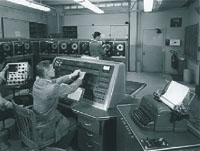
|
|
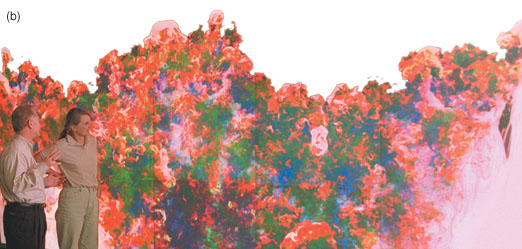
(a)
Results from Univac computations were spewed out as
reams of numbers by a Remington-Rand typewriter modified
to serve as an on-line printer. (b) Results from today’s
complex simulations are converted by powerful visualization
software into three-dimensional detailed views, such
as this one shown on the Livermore-developed PowerWall.
|
|
Mag
Tape and Punch Cards
 Livermore’s
first supercomputer, the Remington-Rand Univac-1, had 5,600 vacuum
tubes and was over 2 meters wide and 4 meters long. Between April
1953 and February 1957, the Univac executed as many calculations
as 440 human “calculators” could perform in 100 years
if they worked 40 hours a week, 52 weeks a year, and made no mistakes.
Memory, however, was an issue. Livermore’s
first supercomputer, the Remington-Rand Univac-1, had 5,600 vacuum
tubes and was over 2 meters wide and 4 meters long. Between April
1953 and February 1957, the Univac executed as many calculations
as 440 human “calculators” could perform in 100 years
if they worked 40 hours a week, 52 weeks a year, and made no mistakes.
Memory, however, was an issue.
 The Univac’s memory
consisted of mercury tanks that could store 9 kilobytes of data—a
tiny fraction of what today’s pocket-sized handhelds can hold.
The code that performed all its operations was stored on magnetic
tapes that had to be loaded into the machine in parts. Calculations
could involve as many as nine tapes, and the nine reel mechanisms
were troublesome, accounting for much of the machine’s 25 percent
downtime. Clearly, machines with more memory were needed. The Univac’s memory
consisted of mercury tanks that could store 9 kilobytes of data—a
tiny fraction of what today’s pocket-sized handhelds can hold.
The code that performed all its operations was stored on magnetic
tapes that had to be loaded into the machine in parts. Calculations
could involve as many as nine tapes, and the nine reel mechanisms
were troublesome, accounting for much of the machine’s 25 percent
downtime. Clearly, machines with more memory were needed.
 With the arrival of the
IBM 701 in 1954, scientists expected that nuclear explosives computations
would run much faster. The IBM, which was the first fully electronic
computer, was 12 times faster than the Univac, had twice the memory,
and primarily used punch cards for input and output. Scientists
took advantage of the improved capabilities to increase resolution
and add more detailed physics, so the computational runs continued
to average 100 hours. With the arrival of the
IBM 701 in 1954, scientists expected that nuclear explosives computations
would run much faster. The IBM, which was the first fully electronic
computer, was 12 times faster than the Univac, had twice the memory,
and primarily used punch cards for input and output. Scientists
took advantage of the improved capabilities to increase resolution
and add more detailed physics, so the computational runs continued
to average 100 hours.
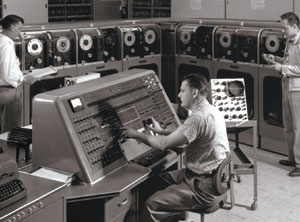 |
The
Univac was the first computer to store information on magnetic
tape. Running a program was a hands-on operation, with a physicist
or programmer toggling console switches to execute the problem.
Although highly accurate, the Univac was cantankerous, breaking
down two or three times a day. Early workers regarded it as
an “oversized toaster.” |
 A series of IBM machines
followed the 701. The IBM 704—twice as fast as the 701—even
played a part in the early space race between the U.S. and the Soviet
Union. Soon after the launch of the Soviet Sputnik I satellite in
October 1957, the Laboratory received an urgent request to help
predict when the satellite would come back to Earth. Livermore’s
IBM 704s were the only computers in the U.S. able to perform the
calculations. Joe Brady, a now-retired Laboratory scientist, recalls,
“We used two 704s for 70 hours straight, only stopping to rush
outside to see the satellite orbiting overhead.” Laboratory
computation workers accurately calculated the satellite’s plunge
into the atmosphere in early December, an extrapolation of 58 days
from launch. The 704s eventually gave way to IBM 709s, which were
faster still, thanks to special-purpose input/output channels to
speed up processing, and batch processing—a new technique that
permitted many individual tasks to be processed without a human
operator’s assistance. A series of IBM machines
followed the 701. The IBM 704—twice as fast as the 701—even
played a part in the early space race between the U.S. and the Soviet
Union. Soon after the launch of the Soviet Sputnik I satellite in
October 1957, the Laboratory received an urgent request to help
predict when the satellite would come back to Earth. Livermore’s
IBM 704s were the only computers in the U.S. able to perform the
calculations. Joe Brady, a now-retired Laboratory scientist, recalls,
“We used two 704s for 70 hours straight, only stopping to rush
outside to see the satellite orbiting overhead.” Laboratory
computation workers accurately calculated the satellite’s plunge
into the atmosphere in early December, an extrapolation of 58 days
from launch. The 704s eventually gave way to IBM 709s, which were
faster still, thanks to special-purpose input/output channels to
speed up processing, and batch processing—a new technique that
permitted many individual tasks to be processed without a human
operator’s assistance.
 In the late 1950s, Edward
Teller proposed that the Laboratory commission a computer from commercial
suppliers. In May 1960, Remington-Rand delivered the Livermore Advanced
Research Computer (LARC) built to Livermore’s specifications.
At that time, there was an international moratorium on nuclear testing,
and upgraded computing capabilities were urgently needed by weapon
designers. With a high-speed magnetic core memory for storing about
240 kilobytes and 12 auxiliary memory drums for storing about 24
megabytes more, the LARC had such dense wiring that technicians
had to use special tools similar to surgical instruments to probe
its insides. Next came the “Stretch,” an IBM machine with
about 780 kilobytes of memory that could perform 100 billion calculations
in a day. In the late 1950s, Edward
Teller proposed that the Laboratory commission a computer from commercial
suppliers. In May 1960, Remington-Rand delivered the Livermore Advanced
Research Computer (LARC) built to Livermore’s specifications.
At that time, there was an international moratorium on nuclear testing,
and upgraded computing capabilities were urgently needed by weapon
designers. With a high-speed magnetic core memory for storing about
240 kilobytes and 12 auxiliary memory drums for storing about 24
megabytes more, the LARC had such dense wiring that technicians
had to use special tools similar to surgical instruments to probe
its insides. Next came the “Stretch,” an IBM machine with
about 780 kilobytes of memory that could perform 100 billion calculations
in a day.
 As the 1960s progressed,
the computer market changed. Most manufacturers abandoned the highly
specialized large-computer market of the national laboratories to
concentrate on the computer needs of the rapidly growing business
and financial markets. In 1963, the Laboratory turned to Control
Data Company (CDC), which furnished all of Livermore’s supercomputers
for the next 15 years, including the CDC 6600 in 1964 and the CDC
7600—10,000 times faster than the original Univac-1—in
1969. The Laboratory received serial number 1 of each of the machines
and, by using them, helped CDC ready their computers for the wider
commercial market. As the 1960s progressed,
the computer market changed. Most manufacturers abandoned the highly
specialized large-computer market of the national laboratories to
concentrate on the computer needs of the rapidly growing business
and financial markets. In 1963, the Laboratory turned to Control
Data Company (CDC), which furnished all of Livermore’s supercomputers
for the next 15 years, including the CDC 6600 in 1964 and the CDC
7600—10,000 times faster than the original Univac-1—in
1969. The Laboratory received serial number 1 of each of the machines
and, by using them, helped CDC ready their computers for the wider
commercial market.
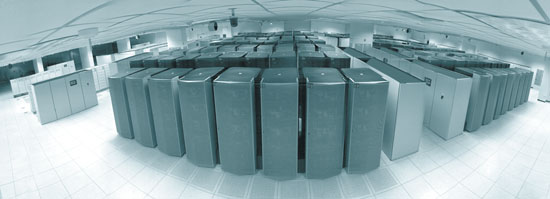 |
| The
ASCI White, with power to perform 12 trillion operations per
second, was delivered to the Laboratory during the summer of
2000. |
Entering a Parallel Universe
 About this time, computers
began exploiting computational parallelism. The CDC STAR-100s in
1976, followed by the Cray 1s, introduced vector architectures.
Cray came out with the first closely coupled processor systems with
its two-processor Cray X-MPs. The final Cray machine, installed
at the National Energy Research Scientific Computing Center (now
located at Lawrence Berkeley National Laboratory), had 16 central
processing units (CPUs) and about 2 megabytes of memory. About this time, computers
began exploiting computational parallelism. The CDC STAR-100s in
1976, followed by the Cray 1s, introduced vector architectures.
Cray came out with the first closely coupled processor systems with
its two-processor Cray X-MPs. The final Cray machine, installed
at the National Energy Research Scientific Computing Center (now
located at Lawrence Berkeley National Laboratory), had 16 central
processing units (CPUs) and about 2 megabytes of memory.
 In the early 1990s, massively
parallel machines—that is, employing scalar architectures—such
as the Meiko and the BBN (by Bolt, Beranek, and Newman) began to
arrive at the Laboratory. As Mike McCoy, a deputy associate director
for Livermore’s Computation Directorate, explains, “About
this time, we began looking at not just sheer capability, which
has been the motivator at the Lab since day one, but price performance
as well. Up to and including the Crays, we would depend on a single
vendor to supply the capability we needed. Part of getting the price
performance we needed involved moving away from specialized processors
for parallel machines to commodity processor systems.” The
Meiko and the BBN were the first supercomputers of this type. Instead
of using a few, enormous, one-of-a-kind processors, the Meiko and
the BBN used many mid-sized workstation processors (the BBN, for
instance, had 128 such processors). “We learned how to build
software for parallel systems on these computers,” notes McCoy.
“These systems were what made us able to transition to the
massively parallel ASCI [Advanced Simulation and Computing program,
formerly called Accelerated Strategic Computing Initiative] systems.” In the early 1990s, massively
parallel machines—that is, employing scalar architectures—such
as the Meiko and the BBN (by Bolt, Beranek, and Newman) began to
arrive at the Laboratory. As Mike McCoy, a deputy associate director
for Livermore’s Computation Directorate, explains, “About
this time, we began looking at not just sheer capability, which
has been the motivator at the Lab since day one, but price performance
as well. Up to and including the Crays, we would depend on a single
vendor to supply the capability we needed. Part of getting the price
performance we needed involved moving away from specialized processors
for parallel machines to commodity processor systems.” The
Meiko and the BBN were the first supercomputers of this type. Instead
of using a few, enormous, one-of-a-kind processors, the Meiko and
the BBN used many mid-sized workstation processors (the BBN, for
instance, had 128 such processors). “We learned how to build
software for parallel systems on these computers,” notes McCoy.
“These systems were what made us able to transition to the
massively parallel ASCI [Advanced Simulation and Computing program,
formerly called Accelerated Strategic Computing Initiative] systems.”
 In 1995, the Department
of Energy and its defense laboratories—Livermore, Los Alamos,
and Sandia—were directed to undertake the activities necessary
to ensure continued stockpile performance in the absence of underground
nuclear testing. DOE’s ASCI program is a key component to meeting
this challenge. The ASCI program is developing a series of ever
more powerful, massively parallel supercomputers that employ thousands
of processors working in unison to simulate the performance of weapons
in an aging nuclear stockpile. The second ASCI supercomputer—the
Blue Pacific, built by IBM—was received at Livermore in September
1996. It was installed, powered up, and running calculations within
two weeks. IBM’s ASCI White, which was delivered to the Laboratory
in three stages during the summer of 2000, is currently the world’s
most powerful computer. Performing 12 trillion operations per second
(teraops), it is 30 billion times faster than the Laboratory’s
very first computer, the Univac-1. In 1995, the Department
of Energy and its defense laboratories—Livermore, Los Alamos,
and Sandia—were directed to undertake the activities necessary
to ensure continued stockpile performance in the absence of underground
nuclear testing. DOE’s ASCI program is a key component to meeting
this challenge. The ASCI program is developing a series of ever
more powerful, massively parallel supercomputers that employ thousands
of processors working in unison to simulate the performance of weapons
in an aging nuclear stockpile. The second ASCI supercomputer—the
Blue Pacific, built by IBM—was received at Livermore in September
1996. It was installed, powered up, and running calculations within
two weeks. IBM’s ASCI White, which was delivered to the Laboratory
in three stages during the summer of 2000, is currently the world’s
most powerful computer. Performing 12 trillion operations per second
(teraops), it is 30 billion times faster than the Laboratory’s
very first computer, the Univac-1.
 In late 1999, Livermore
researchers achieved a major milestone with the first-ever three-dimensional
simulation of a nuclear weapon’s primary (the first stage of
a hydrogen bomb) using the ASCI Blue Pacific. The simulation ran In late 1999, Livermore
researchers achieved a major milestone with the first-ever three-dimensional
simulation of a nuclear weapon’s primary (the first stage of
a hydrogen bomb) using the ASCI Blue Pacific. The simulation ran
a total of 492 hours on 1,000 processors and used 640,000 megabytes
of memory in producing 6 million megabytes of data contained in
50,000 graphics files. A second major milestone, a three-dimensional
simulation of a nuclear weapon secondary, was completed on ASCI
White in spring of 2001. Late in 2001, Livermore and Los Alamos
met a third milestone on this system, coupling the primary and secondary.
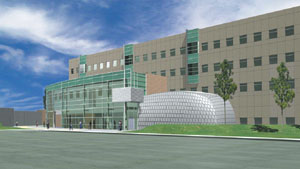 |
A
rendering of the Terascale Simulation Facility, which will house
ASCI Purple, a machine capable of performing 60 trillion operations
per second. |
Forward
to the Future
 With all that has occurred
in the last 50 years, it’s nearly impossible to predict what
the far future will hold. “To meet ASCI’s requirements,
more powerful processors with more memory are needed to create a
proxy of the world around us, from the microscale to the macroscale,”
says Dona Crawford, associate director of Computation. “At
the same time, we are creating terabytes—soon to be petabytes—of
data.” Two trends, Crawford notes, need to continue into the
near future. First, the Laboratory must acquire faster processors
with more memory for simulation and modeling. Second, new ways must
be created for storing, finding, visualizing, and extracting the
data. “We need to merge high-end computing and high-end information
technology,” she concludes. “Scientific data management,
in particular, is becoming more of an issue.” (See the box
below.) With all that has occurred
in the last 50 years, it’s nearly impossible to predict what
the far future will hold. “To meet ASCI’s requirements,
more powerful processors with more memory are needed to create a
proxy of the world around us, from the microscale to the macroscale,”
says Dona Crawford, associate director of Computation. “At
the same time, we are creating terabytes—soon to be petabytes—of
data.” Two trends, Crawford notes, need to continue into the
near future. First, the Laboratory must acquire faster processors
with more memory for simulation and modeling. Second, new ways must
be created for storing, finding, visualizing, and extracting the
data. “We need to merge high-end computing and high-end information
technology,” she concludes. “Scientific data management,
in particular, is becoming more of an issue.” (See the box
below.)
|
From
Personal Computers to Clusters
|
|
 While supercomputers were always an integral part of
Livermore’s nuclear weapons design and stockpile
stewardship efforts, other areas of the Laboratory also
benefited from the computer revolution, particularly
as computer systems became smaller, more powerful, and
less expensive. In the 1970s, small microprocessor systems
such as the PDP-11 began to be used in research tasks—digitizing
oscilloscope traces, for example, and controlling experiments
in chemistry labs. Then the personal computer, or PC,
arrived, followed by more powerful microcomputers and
workstations.
While supercomputers were always an integral part of
Livermore’s nuclear weapons design and stockpile
stewardship efforts, other areas of the Laboratory also
benefited from the computer revolution, particularly
as computer systems became smaller, more powerful, and
less expensive. In the 1970s, small microprocessor systems
such as the PDP-11 began to be used in research tasks—digitizing
oscilloscope traces, for example, and controlling experiments
in chemistry labs. Then the personal computer, or PC,
arrived, followed by more powerful microcomputers and
workstations.
 By the mid-1990s,
many researchers in nonweapons areas were taking advantage
of the relatively inexpensive and powerful desktop computers
in their offices, or they used terminals tied to scientific
workstations. Although having many advantages, these
machines did not always have the necessary computational
power, particularly for running three-dimensional simulations,
which require the enormous computational horsepower
of the latest generation of By the mid-1990s,
many researchers in nonweapons areas were taking advantage
of the relatively inexpensive and powerful desktop computers
in their offices, or they used terminals tied to scientific
workstations. Although having many advantages, these
machines did not always have the necessary computational
power, particularly for running three-dimensional simulations,
which require the enormous computational horsepower
of the latest generation of
(a)

|
supercomputers.
Finally, in 1996, Livermore programs and researchers
outside the stockpile stewardship effort gained access
to unclassified Accelerated Strategic Computing Initiative–level
terascale supercomputers through the Multiprogrammatic
and Institutional Computing Initiative (M&IC). (See
S&TR, October 2001, pp. 4–12.)
 The M&IC
acquired increasingly more powerful clusters, or groups,
of computers such as the Compaq TeraCluster2000. As
the Laboratory begins to celebrate its 50th year, Livermore
researchers are at the forefront of simulating a wide
range of physical phenomena in the unclassified arena,
including the fundamental properties of materials, complex
environmental processes, biological systems, and the
evolution of stars and galaxies. Mike McCoy, deputy
associate director for Integrated Computing and Communications,
says, “Livermore Computing has become an institutional
resource much like the library, a place where researchers
from any program can expect resources to support their
research.” The M&IC
acquired increasingly more powerful clusters, or groups,
of computers such as the Compaq TeraCluster2000. As
the Laboratory begins to celebrate its 50th year, Livermore
researchers are at the forefront of simulating a wide
range of physical phenomena in the unclassified arena,
including the fundamental properties of materials, complex
environmental processes, biological systems, and the
evolution of stars and galaxies. Mike McCoy, deputy
associate director for Integrated Computing and Communications,
says, “Livermore Computing has become an institutional
resource much like the library, a place where researchers
from any program can expect resources to support their
research.”
(b)
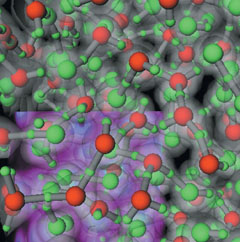
|
| Particle
tracking past and present contributes to a better understanding
of the fundamental properties of materials. (a) In this
example of Livermore physicist Berni Alder’s pioneering
computer simulation work, published in Physics Review
in 1962, a simulation performed on the Livermore Advanced
Research Computer supercomputer tracked 870 particles
over time. (b) Recent work on the ASCI Blue Pacific includes
this quantum-level simulation of a mixture of hydrogen
fluoride and water molecules at high temperatures and
pressures. The simulation tracked hundreds of atoms and
thousands of electrons extremely accurately. |
|
 Within three years, the ASCI
community plans to locate a 60-teraops machine with approximately
20,000 processors—the Purple machine—at Livermore in the
soon-to-be-built Terascale Simulation Facility. Groundbreaking for
this facility will occur in spring of this year. Beyond Purple lies
a world of tantalizing prospects, including BlueGene/L (L stands
for light), a machine 15 times faster than today’s fastest
supercomputers. “BlueGene/L would be a radical departure from
previous machines,” notes Mark Seager, program manager for
ASCI Terascale Systems. BlueGene/L would use IBM’s “system
on a chip” based on commercial embedded-processor technology.
Seager explains, “Embedded processors are optimized for low
cost and low power and for usability in many configurations.”
McCoy notes that systems like BlueGene/L are the next big step in
getting more performance at a lower price. “From ASCI Red to
Purple, the systems use workstation processors targeted at the high-performance
computing market. With BlueGene/L, we’d move from that curve
to one using commodity PC processors. At the same time, we’d
also move from using proprietary vendor software to open-source
software such as the Linux operating system. These moves would result
in considerably lower costs for the power we’d get—about
$0.1 million per teraops for BlueGene/L, compare with White’s
$9 million per teraops or Purple’s $3 million per teraops.” Within three years, the ASCI
community plans to locate a 60-teraops machine with approximately
20,000 processors—the Purple machine—at Livermore in the
soon-to-be-built Terascale Simulation Facility. Groundbreaking for
this facility will occur in spring of this year. Beyond Purple lies
a world of tantalizing prospects, including BlueGene/L (L stands
for light), a machine 15 times faster than today’s fastest
supercomputers. “BlueGene/L would be a radical departure from
previous machines,” notes Mark Seager, program manager for
ASCI Terascale Systems. BlueGene/L would use IBM’s “system
on a chip” based on commercial embedded-processor technology.
Seager explains, “Embedded processors are optimized for low
cost and low power and for usability in many configurations.”
McCoy notes that systems like BlueGene/L are the next big step in
getting more performance at a lower price. “From ASCI Red to
Purple, the systems use workstation processors targeted at the high-performance
computing market. With BlueGene/L, we’d move from that curve
to one using commodity PC processors. At the same time, we’d
also move from using proprietary vendor software to open-source
software such as the Linux operating system. These moves would result
in considerably lower costs for the power we’d get—about
$0.1 million per teraops for BlueGene/L, compare with White’s
$9 million per teraops or Purple’s $3 million per teraops.”
 BlueGene/L would have 65,000
nodes or cells, 360 teraops—larger than the total computing
power of the top 500 supercomputers in the world today—and
between 16 and 32 terabytes of memory. “The questions facing
us for BlueGene/L are: Can we build it? Can we write software for
it? Can we write scientific simulations for it? We believe the answers
are ‘yes’ to all,” says Seager. Six times more powerful
than ASCI Purple, BlueGene/L would open new vistas in scientific
simulation. “For instance,” says Seager, “you begin
to approach what you need to model complex biological systems. Having
BlueGene/L would be like having an electron microscope when everyone
else has optical microscopes, it’s that much of a leap forward.” BlueGene/L would have 65,000
nodes or cells, 360 teraops—larger than the total computing
power of the top 500 supercomputers in the world today—and
between 16 and 32 terabytes of memory. “The questions facing
us for BlueGene/L are: Can we build it? Can we write software for
it? Can we write scientific simulations for it? We believe the answers
are ‘yes’ to all,” says Seager. Six times more powerful
than ASCI Purple, BlueGene/L would open new vistas in scientific
simulation. “For instance,” says Seager, “you begin
to approach what you need to model complex biological systems. Having
BlueGene/L would be like having an electron microscope when everyone
else has optical microscopes, it’s that much of a leap forward.”
 And after that? “Perhaps
there will be computers that align DNA to do processing, or Josephson
junction machines, or all-optical machines. Who knows what will
happen in hardware, software, and information technology in the
next 50 years,” says Crawford. “Whatever innovation ends
up driving the next era in computing will probably explode on the
scene, much like the Internet did.” And after that? “Perhaps
there will be computers that align DNA to do processing, or Josephson
junction machines, or all-optical machines. Who knows what will
happen in hardware, software, and information technology in the
next 50 years,” says Crawford. “Whatever innovation ends
up driving the next era in computing will probably explode on the
scene, much like the Internet did.”
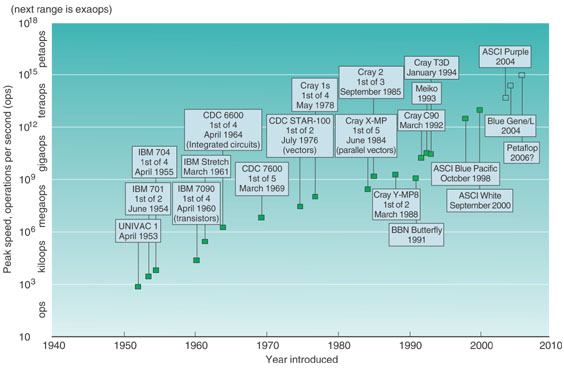 |
| Timeline
of Livermore’s key supercomputers and their peak computing
power. |
 Fifty years ago, the birth
of the electronic scientific computer ushered in a new era. Rather
than having to accept crude approximations because the more exact
equations were too difficult to solve, scientists could use the
great speed and high accuracy of computers to simulate the phenomena
they were trying to understand. Livermore researchers pushed the
limits of each advanced machine, from using crude one-dimensional
codes on the Univac and early IBM machines to complex three-dimensional
codes on the current ASCI machines. Through ASCI and the coming
generations of supercomputing machines, another era appears on the
horizon, an era in which enormously fast and powerful supercomputers
will allow computer simulation to come into its own as a predictive
science along with theory and experiment. Fifty years ago, the birth
of the electronic scientific computer ushered in a new era. Rather
than having to accept crude approximations because the more exact
equations were too difficult to solve, scientists could use the
great speed and high accuracy of computers to simulate the phenomena
they were trying to understand. Livermore researchers pushed the
limits of each advanced machine, from using crude one-dimensional
codes on the Univac and early IBM machines to complex three-dimensional
codes on the current ASCI machines. Through ASCI and the coming
generations of supercomputing machines, another era appears on the
horizon, an era in which enormously fast and powerful supercomputers
will allow computer simulation to come into its own as a predictive
science along with theory and experiment.
—Ann Parker
Key Words: Advanced
Simulation and Computing (ASCI), ASCI BlueGene/L, ASCI Purple, ASCI
White, computation history, Cray, IBM, Livermore Advanced Research
Computer (LARC), supercomputer, Univac.
For further
information, see the following Web sites on computation, past and
present:
Computation
at LLNL:
www.llnl.gov/comp/
ASCI at LLNL:
www.llnl.gov/asci/
Oral History of Computation at LLNL:
www.nersc.gov/~deboni/Computer.history/
For further
information about the Laboratory’s 50th anniversary celebrations,
see the following Web site:
www.llnl.gov/50th_anniv/
|